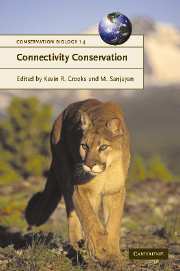Book contents
- Frontmatter
- Contents
- List of contributors
- Acknowledgements
- 1 Connectivity conservation: maintaining connections for nature
- PART I Approaches to connectivity research
- PART II Assessing connectivity
- Introduction: evaluating and quantifying the conservation dividends of connectivity
- 12 Quantifying connectivity: balancing metric performance with data requirements
- 13 Assessing connectivity in salmonid fishes with DNA microsatellite markers
- 14 Individual-based modeling as a tool for conserving connectivity
- 15 Linking connectivity to viability: insights from spatially explicit population models of large carnivores
- 16 Impacts of corridors on populations and communities
- 17 Exploring the functional connectivity of landscapes using landscape networks
- PART III Challenges and implementation of connectivity conservation
- Index
- References
12 - Quantifying connectivity: balancing metric performance with data requirements
Published online by Cambridge University Press: 24 May 2010
- Frontmatter
- Contents
- List of contributors
- Acknowledgements
- 1 Connectivity conservation: maintaining connections for nature
- PART I Approaches to connectivity research
- PART II Assessing connectivity
- Introduction: evaluating and quantifying the conservation dividends of connectivity
- 12 Quantifying connectivity: balancing metric performance with data requirements
- 13 Assessing connectivity in salmonid fishes with DNA microsatellite markers
- 14 Individual-based modeling as a tool for conserving connectivity
- 15 Linking connectivity to viability: insights from spatially explicit population models of large carnivores
- 16 Impacts of corridors on populations and communities
- 17 Exploring the functional connectivity of landscapes using landscape networks
- PART III Challenges and implementation of connectivity conservation
- Index
- References
Summary
INTRODUCTION
Connectivity is an intuitively appealing and useful notion that is now a central concept in ecology and conservation science. Unfortunately, like many ideas that resonate widely, connectivity is plagued with a variety of definitions, interpretations, and methods of measurement. For example, several recent theoretical reviews have detailed how differences in spatial scale and underlying concepts influence how the issue of connectivity is addressed in landscape ecology and metapopulation ecology (Taylor et al. 1993; Tischendorf and Fahrig 2000; Moilanen and Hanski 2001; Tischendorf 2001a; Moilanen and Nieminen 2002). While definitions and measurement might seem boringly technical, conservation scientists must work to identify clear, replicable, and well-understood metrics of connectivity if conservation is to invest funds and efforts wisely and responsibly. Because connectivity is widely believed to facilitate population persistence in a fragmented landscape, on-the-ground applications of connectivity typically involve favoring one landscape configuration or reserve design over alternatives because of improved connectivity (e.g., Siitonen et al. 2002, 2003; Singleton et al. 2002; Cabeza 2003). The metrics used to make these decisions clearly matter. However, despite the importance of developing the theoretical foundations of connectivity, land managers are more likely to be interested in practical issues surrounding the measurement of connectivity. Most importantly, connectivity metrics must be pragmatic and based upon data that might actually be attained on a regular basis.
- Type
- Chapter
- Information
- Connectivity Conservation , pp. 297 - 317Publisher: Cambridge University PressPrint publication year: 2006
References
- 51
- Cited by

